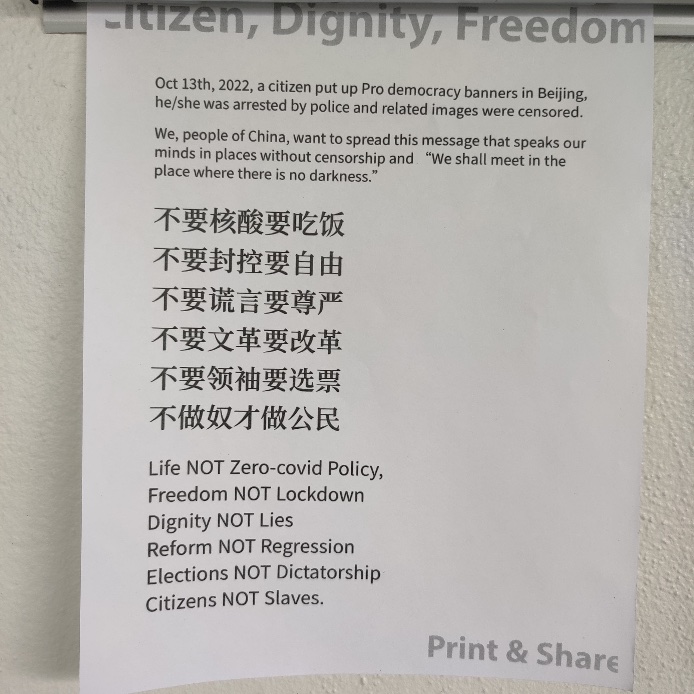Translation strategies: open protest at Sitong (Four-Way) Bridge
« previous post | next post »
Pro-China democracy flyer posted outside University of Miami classrooms:
The Chinese text says:
bùyào hésuān yào chīfàn
bùyào fēngkòng yào zìyóu
bùyào huǎngyán yào zūnyán
bùyào wéngé yào gǎigé
bùyào lǐngxiù yào xuǎnpiào
bù zuò núcái zuò gōngmín
不要核酸要吃饭
不要封控要自由
不要谎言要尊严
不要文革要改革
不要领袖要选票
不做奴才做公民
We don't want nucleic acid testing, we want food to eat;
We don't want lockdowns, we want freedom;
We don't want lies, we want dignity;
We don't want Cultural Revolution, we want reform;
We don't want [dictatorial] leaders, we want elections;
We don't want to be slaves, we want to be citizens.
The English ability of the person who did the translation on the flyer is excellent, but they have radically departed from the wording of the original Chinese text, without losing the spirit or the meaning.
The same flyer appeared at George Washington University, and someone at a small college in the Midwest says there’s a buzz about them on social media. All of my students from the PRC are stunned that this happened just before Xi Jinping convened the 20th National Congress of the CCP at which he is to be coronated Paramount Leader of the PRC for life. Moreover, this sensational event took place not far from the Central Party School and right in the intellectual heart of Beijing, where the May 4th Movement (an anti-imperialist, pro-democracy and pro-science, cultural, and political movement that grew out of student protests in Beijing on May 4, 1919) occurred a little over a century ago. There can be no doubt that the heroic sacrifice of the person who carried out this protest is having an enormous impact, one that may ultimately equal the monumental consequences of the May 4th Movement (e.g., the vernacularization of language and literature).
Selected readings
- "Political regulation of Chinese languages" (10/5/22)
- "The Great Translation Movement" (4/19/22)
- "Malign Woodpeckers and Other Hegemonic Behavior" (4/18/22) — with lengthy bibliography
- "Hu Shih and Chinese language reform" (2/4/17)
[Thanks to June Teufel Dreyer]

Jonathan Smith said,
October 20, 2022 @ 12:02 pm
Good one — I was also trying to improve on translations in Western media / on Chinese Twitter… the Guardian etc. also used “We want food, not…" etc. which IMO is over-wordy / over-literal in its treatment of bu2 yao4 不要 etc… I tried "No more ___ we want ___". This flyer seems to be still plainer thus better… though rhythm would be nice
Text of this and the other banners etc. at
wiki page
Victor Mair said,
October 20, 2022 @ 3:29 pm
"Anti-Xi Jinping Posters Are Spreading in China via AirDrop"
"This is the first time I saw or received a medium of any kind that is critical of the current regime."
by Rachel Cheung, Vice (10/19/22)
https://www.vice.com/en/article/wxn7nq/anti-xi-jinping-posters-are-spreading-in-china-via-airdrop
Victor Mair said,
October 20, 2022 @ 3:33 pm
God bless AirDrop!
https://en.wikipedia.org/wiki/AirDrop
Victor Mair said,
October 20, 2022 @ 3:41 pm
From Geremie Barmé:
The May Fourth Movement neither started at Haidian nor was it the focus. Peking University was at what is now known as the old 紅樓 at 沙灘兒, just north-east of the Forbidden City. Students of PKU led the protest to Tiananmen, which was only a short walk away along Bei/ Nan Changjie.
The Communists took over Yenching University on the early 1950s and renamed the campus Peking University as part of their radical centralisation of tertiary educational institutions.
liuyao said,
October 20, 2022 @ 8:30 pm
The translation I liked best is by Selina Wang on CNN: Say No to… , Yes to …
Will Fitzgerald said,
October 20, 2022 @ 9:31 pm
“We shall meet in the place where there is no darkness” is from Nineteen Eighty-Four, I believe.
Mark Metcalf said,
October 21, 2022 @ 7:30 am
This China Digital Times report includes protest posters containing the text, as well as some very clever memes:
https://chinadigitaltimes.net/2022/10/protest-posters-the-flames-of-sitong-bridge-cannot-be-extinguished/